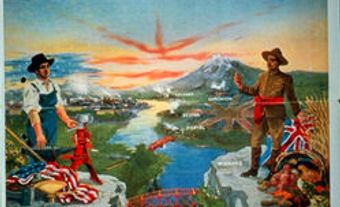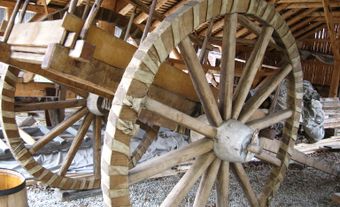The Cariboo Gold Rush (1861–67) is British Columbia’s most famous gold rush.

The Cariboo Gold Rush took place in the remote, isolated Cariboo Mountains region between approximately 1861 and 1867. It began when prospectors drawn from the Fraser River Gold Rush discovered gold on the Horsefly River. After news spread of the rich payload found near bedrock at Barkerville, a large number of gold-seekers were also drawn to the former fur-trading territories of Chilcotin and Carrier. To improve transportation to the Cariboo gold fields, Governor James Douglas ordered construction of the Cariboo Road, a 650 km route from Yale to Barkerville.

View of Barkerville on B.C.'s entrance to Confederation, ca. 1869
(courtesy Library and Archives Canada / PA-061940)
Unlike the Fraser River Gold Rush, which saw a massive influx of American miners, the Cariboo Gold Rush attracted many Canadians. The Overlanders of 1862, who travelled west from Fort Garry [Winnipeg, Manitoba] to the British Columbian interior, included men from Canada West [Ontario], Canada East [ Quebec], New York State, the United Kingdom and Australia.

“Tales Over the Camp Fire.” Sketch by artist William George Richardson Hind, July 1862. Hind kept a sketchbook while accompanying the Overlanders of 1862, who travelled
from Fort Garry [Winnipeg] to the interior of British Columbia in search of gold.
(Sketch by WGR Hind, courtesy Library and Archives Canada, Acc. No. 1963-97-1.40R)
Did you know?
The Overlanders of 1862 included Augustus and Catherine Schubert and their three children. Catherine, the only woman Overlander, made the perilous journey while pregnant. She gave birth to her fourth child in Kamloops, British Columbia. The group also included artist William George Richardson Hind.

Lower End of Williams Creek, Marysville, Cariboo District (British Columbia, 1865).
(photo by Charles Gentile, courtesy Library and Archives Canada/C-088925)
The most promising discoveries of free gold were made at Williams, Lightning and Lowhee Creeks. Williams Creek (125 km southeast of Prince George) was the richest and became the centre of mining operations for the district. Here, in a canyon with a narrow, steep-sided and isolated creek bed, a trio of supply, service and administrative towns was established: Richfield, Camerontown and Barkerville. Barkerville is the only one of the three to outlast the mining boom days.
Barkerville's rich deposits were worked from 1864 to the 1930s. This required the use of expensive and complex technology, including hydraulic monitors which directed jets of water to wash the gold-bearing hillsides into sluice boxes, and the development of a more permanent mining community. Placer gold production in the Cariboo approximated $50 million.

View of a mining town in the Cariboo District (British Columbia, 1865).
(Photo by Charles Gentile, courtesy Library and Archives Canada/C-088916)

 Share on Facebook
Share on Facebook Share on X
Share on X Share by Email
Share by Email Share on Google Classroom
Share on Google Classroom


